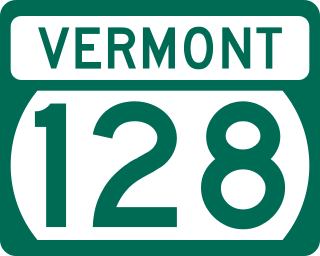
Chittenden County is the most populous county in the U.S. state of Vermont. As of the 2020 census, its population was 168,323. The county seat is Vermont's most populous municipality, the city of Burlington. The county has over a quarter of Vermont's population and more than twice the population of Vermont's second-most populous county, Rutland. The county also has more than twice the population density of Vermont's second-most dense county, Washington. The county is named for Vermont's first governor and one of the framers of its constitution as an independent republic and later U.S. state, Thomas Chittenden.

Charlotte is a town in Chittenden County, Vermont, United States. The town was named for Queen Charlotte, though unlike Charlotte, North Carolina, Charlottesville, Virginia, and other cities and towns that bear her name, the town's name is pronounced with the accent on the second syllable. The population of the town was 3,912 at the 2020 census.

Colchester is a town in Chittenden County, Vermont, United States. As of the 2020 census, the population of Colchester was 17,524. It is the third-most populous municipality and most populous town in the state of Vermont. Colchester borders Burlington, Vermont's most populous municipality. The town is directly to Burlington's north on the eastern shore of Lake Champlain, to the west of the Green Mountains. The Vermont National Guard is based in the town, and it is also home to Saint Michael's College and the Vermont campus of Southern New Hampshire University.

Essex Junction is a city in Chittenden County, Vermont, United States. As of the 2020 U.S. census, the population was 10,590. It was incorporated as a village on November 15, 1892. Essex Junction became Vermont’s 10th city on July 1, 2022.

Hinesburg is a town in Chittenden County, Vermont, United States. The town was named for Abel Hine, town clerk. The population was 4,698 at the 2020 census.

Huntington is a town in Chittenden County, Vermont, United States. The population was 1,938 at the 2020 census.

Shelburne is a town in Chittenden County, Vermont, United States. Located along the shores of Lake Champlain, Shelburne's town center lies approximately 7 miles (11 km) south of the city center of Burlington, the largest city in the state of Vermont. As of the 2020 census, the population of Shelburne was 7,717.

South Burlington is a city in Chittenden County, Vermont, United States. Along with neighboring Burlington, it is a principal city of the Burlington metropolitan area. As of the 2020 U.S. census, the population was 20,292, making it the second largest city in Vermont. It is home to the headquarters of Ben & Jerry's and the state of Vermont's largest mall, the University Mall.

Underhill is a town in Chittenden County, Vermont, United States. The population was 3,129 at the 2020 census.

Westford is a town in Chittenden County, Vermont, United States. The population was 2,062 at the 2020 census.

Williston is a town in Chittenden County, Vermont, United States. Originally rural and laid out with many farms, in recent decades it has developed into a thriving suburb of Burlington, the largest city in the state of Vermont. As of the 2020 census, the population of Williston was 10,103, an increase of over 1,000 people since the 2010 census. Williston is one of the fastest-growing towns in Vermont, and while becoming more populated, it has also developed as a major retail center for the Burlington area as well as much of central and northern Vermont. The town has a National Register Historic District in its unincorporated central village.

Fairfax is a town in Franklin County, Vermont, United States. The population was 5,014 at the 2020 census.

Westmore is a town in Orleans County, Vermont, United States. The population was 357 at the 2020 census, making it the least populated and least densely populated town in the county. The town contains one unincorporated village clustered around Lake Willoughby.

Jericho is a town in Chittenden County, Vermont, United States. As of the 2020 census, the population was 5,104. The town was named after the ancient city of Jericho.
Essex High School (EHS) is a public secondary school located in Essex Junction, Vermont. The school's sports team is the Hornets, and the school's colors are blue and gold. Essex High School is the second largest high school after CVU and is the largest secondary technical school in Vermont. Enrollment in 2021 was 1,251. It is ranked #2,672 among all high schools nationwide.
The Chittenden Senate District was one of 13 Vermont Senate districts included in the redistricting and reapportionment plan developed by the Vermont General Assembly. After the 2022 Census, it was divided into three districts.

The Burlington metropolitan area is a metropolitan area consisting of the three Vermont counties of Chittenden, Franklin, and Grand Isle. The metro area is anchored by the principal cities of Burlington, South Burlington, St. Albans, Winooski, and Essex Junction; and the towns of Colchester, Essex and Milton. According to 2020 U.S. Census, the metro area had a population of 225,562, approximately one third of Vermont's total population.

Vermont Route 128 (VT 128) is a 11.616-mile-long (18.694 km) north–south state highway in northwestern Vermont, United States. The southern terminus of the route is at VT 15 in Essex, Chittenden County. Its northern terminus is at VT 104 in Fairfax, Franklin County.

Tanya C. Vyhovsky is an American social worker and politician who has served in the Vermont Senate since January 2023. A member of the Vermont Progressive Party, she previously represented the Chittenden-8-1 district in the Vermont House of Representatives.
Westford is the primary village and a census-designated place (CDP) in the town of Westford, Chittenden County, Vermont, United States. It was first listed as a CDP prior to the 2020 census.




















